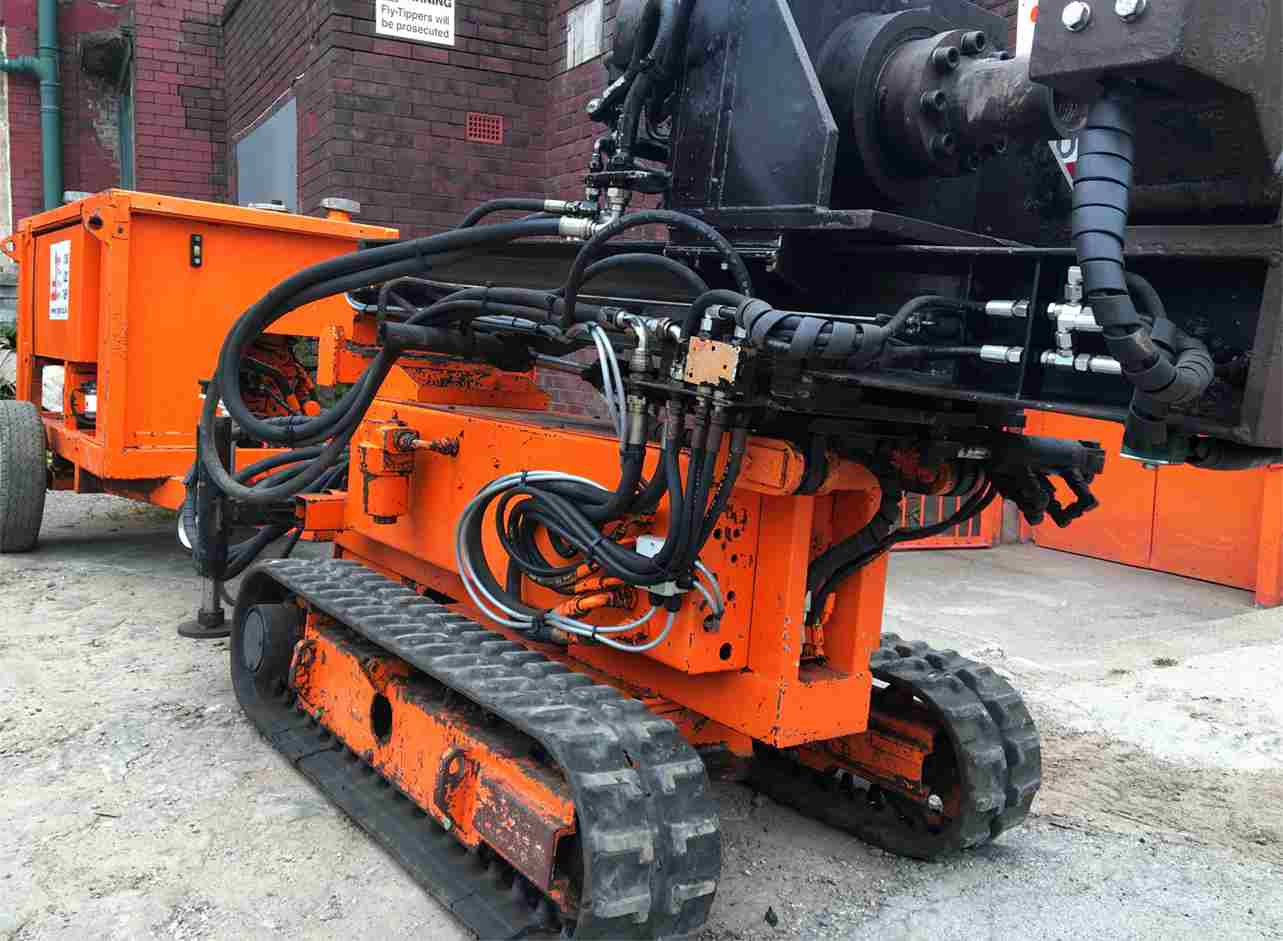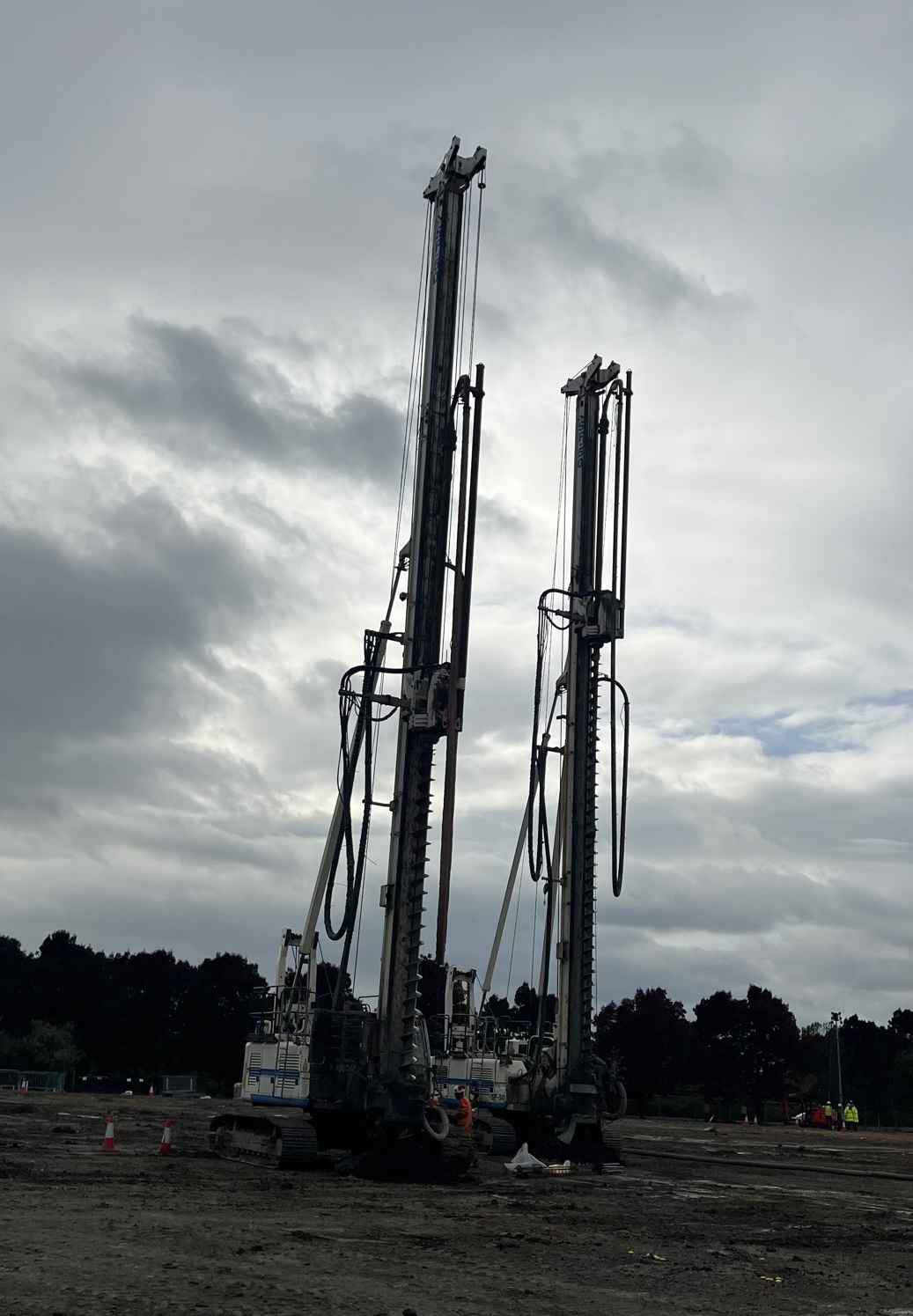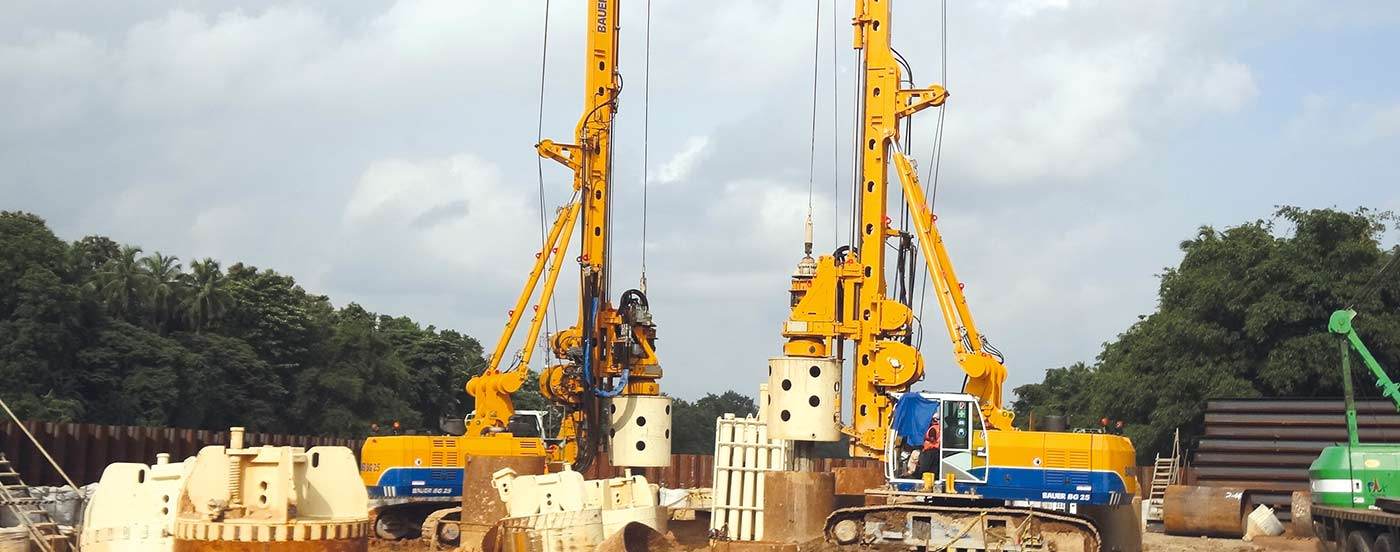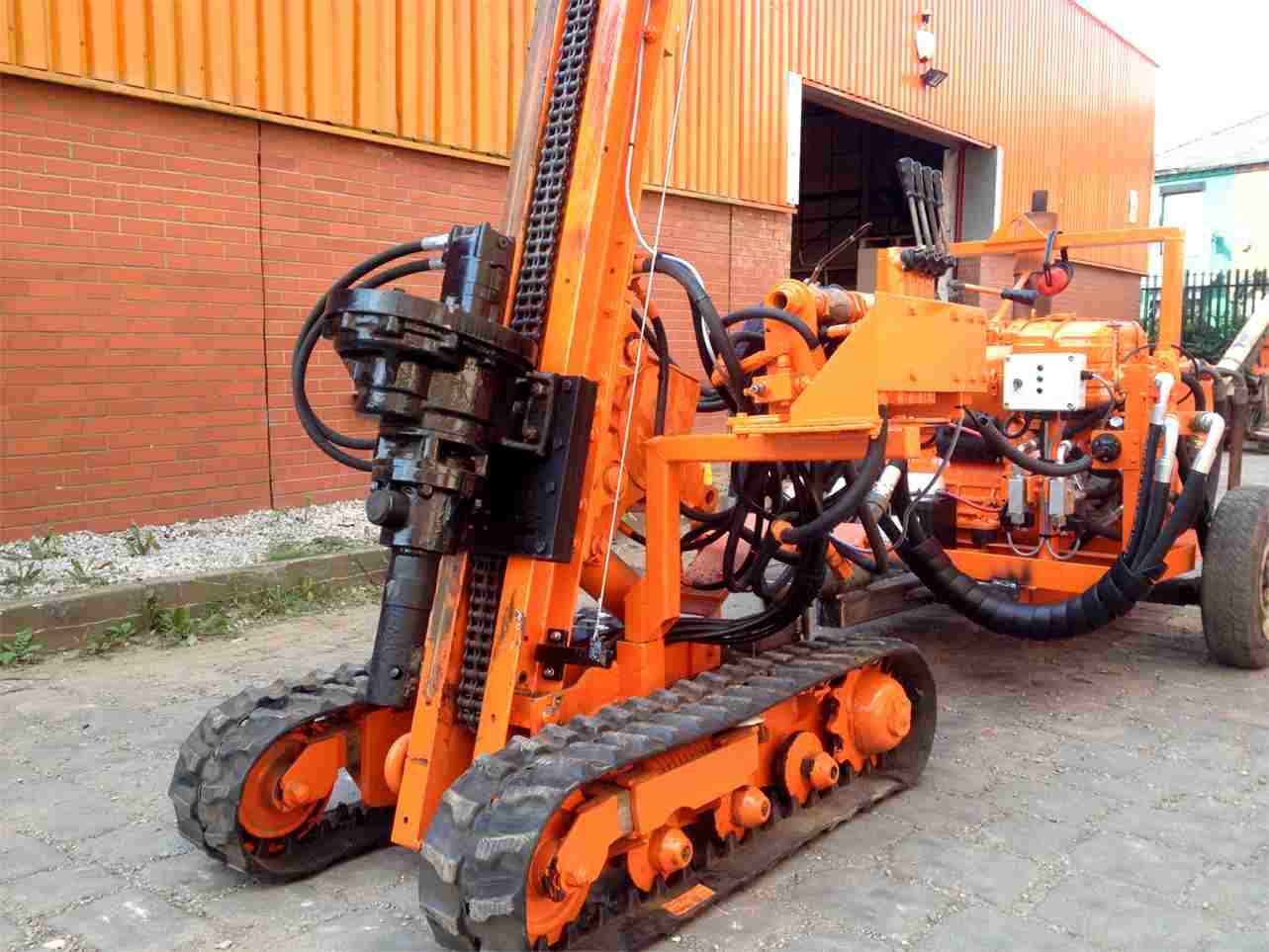A Comprehensive Guide to Piling, Its Types & Construction

Piling is the technique of inserting piles (columns or posts) into the ground to provide support for buildings or other structures. It is typically used in situations where the soil is not stable enough to support a structure directly or where the structure needs to be elevated above ground level.
The piles can be made from various materials, including metal, steel, concrete, or wood. It transfers the structure weight through columns or piles built deep into the ground to a stable layer of soil or rock. This process helps to support the structure and prevent it from settling or shifting over time.
Pile VS Pile Foundations
Pile and pile foundations are closely related terms in construction but have different meanings. Pile refers to a single column or post driven into the ground to support a structure, while pile foundation refers to a system of multiple piles used together to support a structure.
In other words, a pile is a single unit of support, while a pile foundation is a group of piles that work together to provide a stable foundation for a structure. Pile foundations can be used for a variety of structures, including buildings, bridges, and other types of heavy-duty infrastructure.
Mon–Fri: 8:00am-6:00pm
Skilled Labour
Customer Satisfaction
Advanced Machines
History of Piling in Construction
Piling has a long history dating back to ancient times when wooden piles were used to support structures in marshy areas or the water. The ancient Romans used wooden piles to support bridges and aqueducts, while the Egyptians used them to support buildings in areas prone to flooding.
In the 19th century, the introduction of steam-powered pile drivers revolutionised the construction industry by making it possible to drive piles much deeper into the ground than ever before. This led to the development of new pile materials, such as cast iron and steel, which were stronger and more durable than wood.
During the 20th century, piling technology continued to advance, with the development of new techniques such as drilled piles and auger-cast piles, which allowed for more efficient and precise installation of piles.
Today, piling is an essential part of modern construction, used to support structures ranging from tall skyscrapers to offshore oil platforms. Advanced materials and equipment, such as high-strength steel and hydraulic pile drivers, have made it possible to drive piles deeper and more efficiently.
What Are Main Piling Types?
Friction piles and end-bearing piles are two different types of pile foundations, distinguished by how they transfer a structure load to the ground.
Friction Piles
These piles rely on the frictional resistance between the surface of the pile and the soil surrounding it to transfer a structure’s load to the ground.
Friction piles are typically longer than end-bearing piles, and they work best in cohesive soils with high penetration resistance. They are commonly used in soft or loose soil conditions where the underlying soil layers can’t provide sufficient support.
End bearing Piles
These piles transfer the structure load through the bottom of the pile to a stronger, more stable layer of soil or rock. End-bearing piles are typically shorter than friction piles and are designed to support heavy loads.
They are commonly used in soils with low frictional resistance, such as sand or soft clay, where the structure’s weight needs to be transferred to a more stable layer of soil or rock.
Note: Both friction piles and end-bearing piles can be made from various materials, such as steel, concrete, or timber, and can be installed using various methods, including driven piles, bored piles, auger-cast piles, etc.
The choice of pile type depends on factors such as the soil conditions, the load requirements of the structure, and the available equipment and resources.



Method for Constructing Piles
Driven and bored/ cast-in-situ piles are two primary methods for building foundations and piling on construction sites. Although you may find more types, such as driven and cast-in-situ piles, aggregate piles, etc., all the others are variations of Driven and bored/ cast-in-situ piles. Here is a comprehensive overview of these piling construction methods.
Driven Piles Foundations
Driven piles are a type of pile foundation that are constructed by driving a precast or prefabricated pile into the ground using a pile driving hammer or similar equipment. This method is also sometimes referred to as driven pile foundations.
The process of constructing driven piles involves the following:
- Preparing the ground by excavating any soil or debris and compacting the soil to provide a stable foundation.
- A pile-driving hammer is then used to drive the precast or prefabricated piles into the ground to the required depth.
- A pile cap, used to distribute the structure’s load evenly across the pile, is installed on top of the pile.
- The foundation of the structure is constructed on top of the pile cap.
Note: The piles are usually made of concrete, steel, or wood and can vary in shape and size depending on the design requirements of the structure.
Driven piles can support heavy loads in various soil conditions, including loose or soft soils. Driven piles can also be cost-effective for large projects, as they can be manufactured off-site. However, their installation can generate significant noise and vibration.
Bored/ Cast-In-Situ Piles
Bored or cast-in-situ piles are a type of pile foundation constructed by drilling a hole into the ground and filling it with concrete or other materials to form a pile; the piles are created on the site, unlike the bored, where the precast piles are installed. This method is also sometimes referred to as drilled piles or auger-cast piles.
The process of constructing bored piles involves the following:
- Drilling a hole into the ground using a drilling rig equipped with a drill bit. The design requirements of the structure determine the diameter and depth of the hole.
- A steel reinforcement cage is then lowered into the hole, and concrete is poured into the hole using a concrete pump or similar equipment.
- Once the concrete has set, the top of the pile is trimmed to the required level, and any protrusions or deformities are removed.
Bored piles can support heavy loads in various soil conditions, including hard or rocky soils. They are commonly used in urban areas where noise and vibration from driven piles may be disruptive and can be a good option for sites with limited access or space.
However, they can be slower and more expensive to construct than driven piles due to the specialised equipment and materials required to complete the construction process.
For your information, there are subtypes of the bored/ cast-in-situ piles used for different purposes. Here is an overview of these types.
Rotary Bored Piling
Rotary bored piling is a type of bored pile construction method in which a drilling rig equipped with a drilling tool is used to excavate the soil and create a hole for the pile.
A temporary casing is installed into the hollow structure to support when pouring the concrete and other material. The concrete is poured, and the steel frame is installed; the casing is removed immediately after installation when the concrete is not set yet.
Continuous Flight Auger (CFA) Piling
In the CFA piling method of bored piles, a hollow-stemmed auger is used to drill into the soil while concrete is continuously pumped through the hollow stem of the auger.
The auger is withdrawn from the hole while concrete is pumped through the hollow stem, creating a continuous concrete column. Unlike the rotary bore piling, there is no need to install the temporary casing.
Building a Safe Working Platform
In piling, a working platform is a temporary structure constructed to provide a stable and level surface for the piling rig and workers to operate on. The working platform is typically built adjacent to the area where the piles will be installed and must be able to support the weight of the piling rig and materials.
The working platform provides a safe and stable surface for workers to access the piling rig and perform necessary tasks such as loading materials, preparing piles, and operating the piling equipment. It is also used to support and stabilise the piling rig during the installation process, which can be challenging due to the heavy equipment involved and the nature of the ground being worked on.
The design and construction of the working platform must be carefully planned to ensure that it is safe and stable and can support the weight of the piling rig and materials. The platform must also provide adequate access and egress for workers and be designed to prevent falls or other accidents.
Here are some tips for building a safe working platform for piling:
- Choose a flat, stable and level surface for the working platform
- Ensure the ground has an adequate bearing capacity
- Clear the area of debris and obstructions
- Install appropriate edge protection to prevent falls
- Provide safe access and egress with secure ladders or stairs
- Ensure adequate lighting for visibility
- Provide workers with appropriate personal protective equipment (PPE), including hard hats, safety glasses, and high visibility vests.
